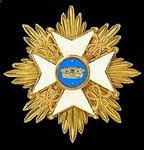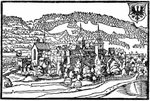I'm sure many of my readers will be aware that, when the Prussians invaded Silesia in an entirely piratical and unprovoked land-grab in 1740, Maria Theresa, who had just become Empress at 23, had neither the money nor time to reflag her army. Consequently her army went to war carrying the flags of her father Charles VI. We know the details of some of the flags but not all and a certain amount of informed speculation is needed when recreating them. The lack of standardisation is certainly colourful and attractive, and the same is true of the uniforms of the period, with coloured waistcoats and breeches, and musicians in varied and very colourful uniforms. From a military perspective, things like the lack of a standardised drill and artillery were not very helpful, though. In the eight years between the end of the War of the Austrian Succession in 1748 and the beginning of the Seven Years War in 1756 the Austrian army underwent a huge transformation, which made it a much more formidable foe to the Prussians; as the Prussian said ruefully after the battle of Lobositz in October 1756, these are not the same Austrians (that they had beaten time and again in the 1740s). From the wargamer's point of view, though, it is a pity that in the process much of the colour and variety were lost!

These are the flags of Austrian Infantry Regiment Deutschmeister as posibly carried in the 1740s. The Leibfahne is somewhat speculative but based on patterns carried by other Austrian regiments. Many Leibfahnen of this period do not seem to have had the Madonna on them, unlike later in the century, but were a simpler variation on the Kompaniefahnen.
A blow by blow account of the regiment can be found on Kronoskaf.
IR No.4 Deutschmeister: First raised 1695
C J Duffy in his book
The Army of Maria Theresa (1977) says:
"Recruited in the Empire and especially the lands of the Teutonic Order. The Inhaber was the current head of the Order. A very famous regiment, distinguished at Camposanto, Rottofreno (1746), Kolin and Landeshut."
On its performance at Kolin: "Next in line to the west was Tresckow's corps which was repelled in fine style by the regiments of Deutschmeister, Baden and Botta."
In his more recent book
By Force of Arms (2008) C J Duffy has a rather more critical account of the regiment. He says: "No.4 Deutschmeister. Proprietors: Wittelsbach, Clemens August, Prince, Elector of Cologne, as Grand Master (Hoch-und-Deutschmeister) of the Teutonic Order; succeeded as Grand Master in 1761 by Charles Alexander, Prince of Lorraine."
"Record: Distinguished at Kolin. Breslau, Leuthen. Stormed the Kirch-Berg at Landeshut. Otherwise of no particular reputation in the war [SYW, that is]. The crusading days of the Teutonic Order were long past, and the order was chiefly of value to the monarchy from its ability to recruit in its extensive lands in Swabia.
Significant losses: Very few prisoners or killed in action... Many deaths in hospital... and third heaviest desertion in the infantry."
He also says (which I cannot find specified anywhere else) that the regiment had black cuffs and lapels. All other sources suggest blue!
I suspect the more critical appraisal in the recent book reflects CJD's extensive new research in the Austrian archives; CJD himself says in the Foreword that rereading his own manuscript he was struck by how critical of the Austrian army it seemed, and that this probably is a consequence of the very warts and all completeness of the archives on the Austrian army, which speak well for the honesty and reliability of the material itself!
I plan to do more flags of this period soon...




































































